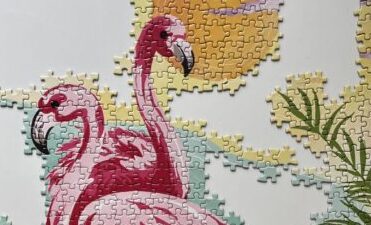
Tips and Tricks to solve a 1000 Piece Puzzle
Hello Piecelovers!! We were doing a big jigsaw puzzle the other day and were struggling to finish it within the timeframe we’d thought we could. In the midst of the task and while figuring out the puzzle we had a few observations, and so we thought we share our two cents on how to go about how to solve a big 1000 piece puzzle.
Jigsaw puzzles are actually an excellent way to unwind and put one’s cell-phone down. In fact it is said to be an activity which provides an outlet to our goal-achieving tendencies through the challenge and subsequent satisfaction of completion of a jigsaw puzzle! Apart from being a fun activity, it sure does help in secretion of dopamine through exercising the juices of our brain and giving a psychological order to the chaos we feel, thus providing a calming effect and making one feel more ‘happy’.
While most small puzzles can be built piece by piece looking at the picture, solving a 1000 piece puzzle (which prefers itself to be called a ‘big puzzle’) takes a more strategic approach. For big puzzles, you want to break it down into small manageable sections and tackle them one at a time so as to finally achieve your masterpiece. In order to help you out with this ‘big task’, we have some tips and tricks for you to get some extra dopamine in!
Dedicated Space and Surface
Big puzzles can take anywhere between 3-10 hours spread out over many evenings depending on the kind of picture the puzzle entails. You would want to dedicate certain space to the puzzle where you or your puzzle won’t be disturbed. Having clarity with respect to the puzzle dimensions and access to a clear flat surface are key to success. This is because moving stations half-way through the puzzle can be frustrating and may hinder the flow of things.
PS: If you are unable to dedicate a permanent large surface, you can always solve the 1000 piece puzzle on a big piece of cardboard (keep puzzle dimensions in mind) that can be moved around/slid under the bed when not working on.
Sorting
This is one of the foremost and important tasks since it provides a method to the madness when starting out with 1000 pieces. Turn all puzzle pieces print-side up and spread them out. While doing so you want to set aside all corners and edge pieces since they secure the perimeters edges and are not lost with similar coloured pieces. Also sort the puzzles according to colours and patterns. Group similar colours or patterns together.
We have listed down a few Sample Sorting Groups which can be used to identify patterns:
-All blues for the sky
-Pieces with car on them
-All greens from a tree (further sorted into dark or light greens)
-Pieces with a house in them
PS: If you don’t have a big space to spread out all the pieces face up, you can use trays and pile them. And only spread out and face up pieces as you solve each tray.
A lot of puzzlers find calm and peace while sorting the pieces. It is said that mindful sorting is equivalent to open-eyed meditation. So we suggest that you put on some good music and enjoy this step till it lasts!
Assemble
While there is no hard and fast rule as to which section you have to start with, usually people put together the edges first, as it gives them the frame and it aids in visualizing the size of each section. If you are missing a piece or two that’s okay (don’t panic) they will turn up later, they always do! If your puzzle’s borders are featureless you can always do them later and start with the definite looking part as it will provide the momentum you seek while starting out. Now begin working through your sections. Start by a section that has large contrasts and is easy to do. More featureless portions like sky or water can be done later. Step-by-step you will see the magic work and will be able to solve a 1000 piece puzzle.
Finishing the Puzzle
After taking up different sections of the jigsaw puzzle, it is time for some compilation. Bring all sections of the puzzle together, filling the gaps and forming the larger scape. The next part is a bit tricky as only pieces with less or no features remain, thus making the puzzle a bit challenging. It is here that perseverance comes into play and you must not give up. Once it is difficult to distinguish puzzles according to colour or features, you can start looking at the puzzle gaps to be filled by complementary puzzle pieces. Sort the remaining pieces according to puzzle shapes to continue. Trial and error is one method that can come in handy. At the end you will see your big puzzle completed with all the pieces coming together to give you your own not-so-little masterpiece.
Voila! There you are – beaming with pride and satisfied with your efforts on successfully achieving the task you had undertaken! Once done you can glue the puzzle – frame it, hang it or use it as a coffee table mat.
If you are working on a Pieceplay Puzzle, a DIY glue kit is included in the box so you can always preserve your art puzzles.
